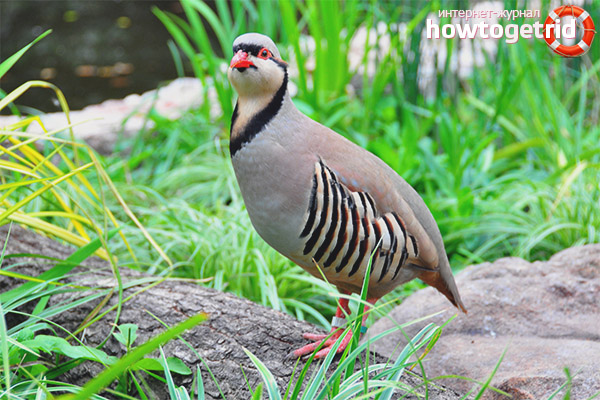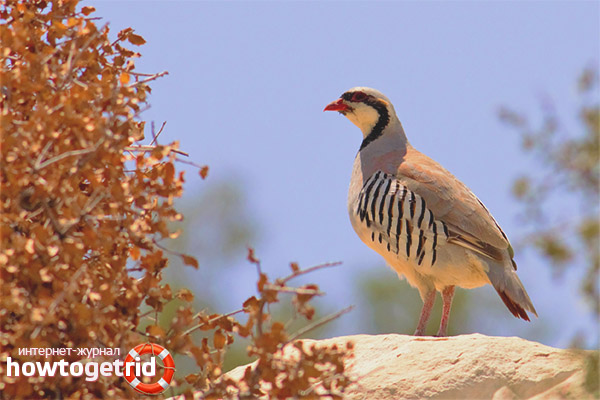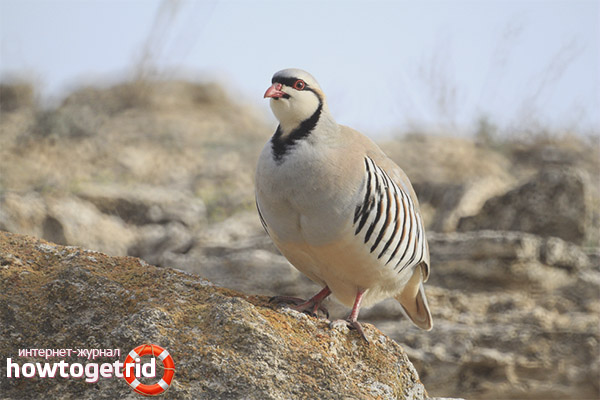The content of the article
Sometimes among the bird polyphony you can hear a loud and jerky "cake, cake-cake" or "coc, coc-coc." This is the singing of a cupcake or stony partridge (stone hen). Because of the special singing of these funny birds, they were nicknamed them - “cupcakes”. Despite its miniature, the feathered voice is so loud that it can be distinguished at a distance of 1.5 km. It is noteworthy that some species of this bird are so similar that they were mistakenly combined into one. This happened with Asian and European muffins. However, the birds still have differences - they sing in different ways.
Habitat
These birds cannot be attributed to migratory. They do not fly away for the winter, preferring the same range. So, they can be found on the territory stretching from the Alps and the Balkan Peninsula to China, as well as the Himalayas. Often cupcakes are found in Altai, the Caucasus and Central Asia. The bird nests on the ground, preferring rocky slopes, deserts, forest edges or ravines with low grasses and shrubs.
Not far from the rocky partridge nest you can always find some kind of pond. Life-giving moisture is especially necessary for them in the hot summer. They often fly up to drink water. In winter, when the water freezes, birds peck snow or ice.
Feathered features
Despite the fact that birds do not belong to migratory birds, they still make seasonal trips along the mountain slopes from time to time, either choosing a higher tier for the nest or descending lower. This behavior of birds is understandable. The fact is that with the onset of cold weather on the lower, blown slopes, it is easier for them to find food. The wind and cold do not frighten them, because low air temperature is easier to carry on a full stomach. A dense winter feather with warm down also helps in this. Feathers help out in the hot season. In the sun, their surface can reach up to 500C. However, the density of the feathers does not allow heat to reach the skin and the bird does not experience overheating. In the summer heat, resting birds are most often seen in the shade, engaged in sand bathing and feather cleaning.
Rocky partridges are active before dark. Waking up with the first rays of the sun, for some time they were talking violently about something, screaming fervently, welcoming the awakening nature. Then comes the time of watering and hunting, when feathered fun fly away to the pond. So, they spend all day getting their own feed. Most often they can be seen walking around the stones than sitting on tree branches.
Nesting and breeding

Birds create couples for life. This happens in the first year of life. In the mating season, they enter the end of February or early March. Having picked up a secluded place under a bush or a ledge of rock, the birds dig their paws in the ground a small depression for future masonry. As a rule, their nests are small: about 20 cm in diameter and no more than 9 cm in depth. Feathered on the bottom of the recess in the ground are covered with dead wood, small branches and down. The nest itself is covered with leaves and grass.
Females of cupcakes are characterized by good fertility. They lay from 7 to 22 eggs, and then hatch them for 23-24 days. Small testicles of birds are painted in a yellowish shade with a splash of brown. With such a coloring, they are very difficult to notice on the ground.
Chicks hatch quickly enough. Very often, babies begin to peck at the same time. They are born in gray fluff with white splashes and very quickly learn to move after their parents - just four hours after birth. Parents jealously monitor their offspring, protect them from danger and warm them up, as At first, the babies are not feathered and may freeze to death. Adults literally from the first days begin to teach their chicks to hunt. If danger arises near the nest, the female begins to run away from him and, pretending to be wounded, leads the enemy away from the nest. At this time, the chicks are hiding somewhere.
Rocky partridges grow quite quickly, reaching two weeks of weight three times more than when hatching. By ten days, young birds begin to get on the wing, flying very short distances. Sometimes babies of several couples are grouped into one large flock, sometimes numbering up to 30 birds. At the same time, several adult birds show concern for young people. Chicks live with adult chubbles for a long time, spending autumn and wintering with them.
Feathered birds feed mainly on plant foods, consuming greens and seeds from various plants. Ornithologists conducted research and found that more than 300 plant species are present in the bird diet. To a lesser extent, the chives consume protein feed. It usually consists of:
- insects
- small worms;
- shellfish.
This little bird has a lot of enemies. Not only animals hunt it, but also birds of prey, as well as humans. Kids suffer most in this regard, although they can hide and disguise themselves.
In especially cold and low snowy winters, the bird population is significantly reduced. This is due to the inborn curiosity of birds, which are easy to lure into pieces of bright fabric stretched over sticks. This is what hunters usually do, who get themselves tasty partridge meat. However, in spring, females again lay a large number of eggs, and by autumn the number of birds is restored.
Interesting Facts

During the mating season you can hear the cupcakes "clucking". The sonorous sound of “ho-ko-ko”, which is produced by a male caring for a female, is somewhat reminiscent of chicken cackling and tocking.
Despite the fact that cupcakes often fall into the hands of people, the latter can be difficult to find. The fact is that the bird is distinguished by excellent briskness and mobility. She runs so fast on a rocky surface that she is not inferior to an excellent hunting dog.
Due to the great fecundity and unpretentiousness, the bird is often bred in a nursery. It is valued for its original plumage and unusual singing. In addition, some lovers grow birds to participate in bird battles. In captivity, the cupcakes feel good and, with proper care, can live up to twenty years.
Video: Keklik (Alectoris)










Submit